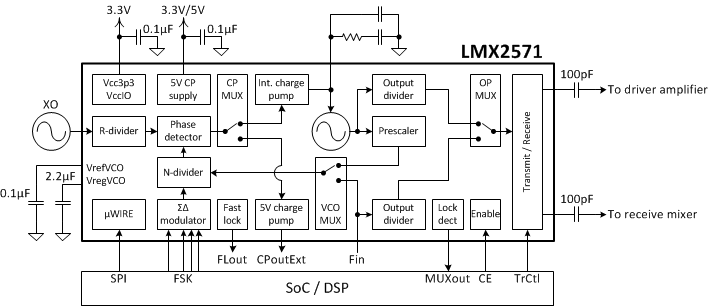ZHCSDH8 March 2015 LMX2571
PRODUCTION DATA.
- 1 特性
- 2 应用
- 3 说明
- 4 修订历史记录
- 5 Pin Configuration and Functions
- 6 Specifications
-
7 Detailed Description
- 7.1 Overview
- 7.2 Functional Block Diagram
- 7.3
Feature Description
- 7.3.1 Reference Oscillator Input
- 7.3.2 R-Dividers and Multiplier
- 7.3.3 PLL Phase Detector and Charge Pump
- 7.3.4 PLL N-Divider and Fractional Circuitry
- 7.3.5 Partially Integrated Loop Filter
- 7.3.6 Low-Noise, Fully Integrated VCO
- 7.3.7 External VCO Support
- 7.3.8 Programmable RF Output Divider
- 7.3.9 Programmable RF Output Buffer
- 7.3.10 Integrated TX, RX Switch
- 7.3.11 Powerdown
- 7.3.12 Lock Detect
- 7.3.13 FSK Modulation
- 7.3.14 FastLock
- 7.3.15 Register Readback
- 7.4 Device Functional Modes
- 7.5 Programming
- 7.6
Register Maps
- 7.6.1 R60 Register (offset = 3Ch) [reset = 4000h]
- 7.6.2 R58 Register (offset = 3Ah) [reset = C00h]
- 7.6.3 R53 Register (offset = 35h) [reset = 2802h]
- 7.6.4 R47 Register (offset = 2Fh) [reset = 0h]
- 7.6.5 R42 Register (offset = 2Ah) [reset = 210h]
- 7.6.6 R41 Register (offset = 29h) [reset = 810h]
- 7.6.7 R40 Register (offset = 28h) [reset = 101Ch]
- 7.6.8 R39 Register (offset = 27h) [reset = 11F0h]
- 7.6.9 R35 Register (offset = 23h) [reset = 647h]
- 7.6.10 R34 Register (offset = 22h) [reset = 1000h]
- 7.6.11 R33 Register (offset = 21h) [reset = 0h]
- 7.6.12 R25 to R32 Register (offset = 19h to 20h) [reset = 0h]
- 7.6.13 R24 Register (offset = 18h) [reset = 10h]
- 7.6.14 R23 Register (offset = 17h) [reset = 10A4h]
- 7.6.15 R22 Register (offset = 16h) [reset = 8584h]
- 7.6.16 R21 Register (offset = 15h) [reset = 101h]
- 7.6.17 R20 Register (offset = 14h) [reset = 28h]
- 7.6.18 R19 Register (offset = 13h) [reset = 0h]
- 7.6.19 R18 Register (offset = 12h) [reset = 0h]
- 7.6.20 R17 Register (offset = 11h) [reset = 0h]
- 7.6.21 R9 to R16 Register (offset = 9h to 10h) [reset = 0h]
- 7.6.22 R8 Register (offset = 8h) [reset = 10h]
- 7.6.23 R7 Register (offset = 7h) [reset = 10A4h]
- 7.6.24 R6 Register (offset = 6h) [reset = 8584h]
- 7.6.25 R5 Register (offset = 5h) [reset = 101h]
- 7.6.26 R4 Register (offset = 4h) [reset = 28h]
- 7.6.27 R3 Register (offset = 3h) [reset = 0h]
- 7.6.28 R2 Register (offset = 2h) [reset = 0h]
- 7.6.29 R1 Register (offset = 1h) [reset = 0h]
- 7.6.30 R0 Register (offset = 0h) [reset = 3h]
-
8 Application and Implementation
- 8.1
Application Information
- 8.1.1 Direct Digital FSK Modulation
- 8.1.2 Frequency and Output Port Switching with TrCtl Pin
- 8.1.3 OSCin Configuration
- 8.1.4 Register R0 F1F2_INIT, F1F2_MODE usage
- 8.1.5 FastLock with External VCO
- 8.1.6 OSCin Slew Rate
- 8.1.7 RF Output Buffer Power Control
- 8.1.8 RF Output Buffer Type
- 8.1.9 MULT Multiplier
- 8.1.10 Integrated VCO
- 8.2 Typical Applications
- 8.3 Do's and Don'ts
- 8.1
Application Information
- 9 Power Supply Recommendations
- 10Layout
- 11器件和文档支持
- 12机械封装和可订购信息
1 特性
- 输出频率范围:10MHz 至 1344MHz
- 低相位噪声和毛刺
- 12.5kHz 偏移 @ 480MHz 时为 –123dBc/Hz
- 1MHz 偏移 @ 480MHz 时为 –145dBc/Hz
- 标准化锁相环 (PLL) 噪底为 –231dBc/Hz
- 杂散优于 –75dBc/Hz
- 新型 FastLock 技术,缩短了锁定时间
- 新型整数边界毛刺去除技术
- 集成 5V 电荷泵和输出驱动器,用于外部压控振荡器 (VCO) 操作
- 2、4 和 8 电平或者任意电平数直接数字移频键控 (FSK) 调制
- 一个 TX/RX 输出或两个扇出输出
- 晶振、XO 或差分参考时钟输入
- 低电流消耗
- 39mA 典型合成器模式(内部 VCO)
- 9mA 典型 PLL 模式(外部 VCO)
- 24 位分数 N Δ-Σ 调制器
2 应用
- 双工模式数字专业双向无线电
- dPMR、DMR、PDT、P25 Phase I
- 低功耗无线电通信系统
- 卫星通信调制解调器
- 无线麦克风
- 专有无线连接
- 手持式测试和测量设备
3 说明
LMX2571 是一款低功耗、高性能、宽带 PLLatinum™ 射频 (RF) 合成器,该合成器集成了 Δ-Σ 分数 N PLL、多核压控振荡器 (VCO)、可编程输出分压器以及两个输出缓冲器。 VCO 内核的工作频率高达 5.376GHz,持续输出频率范围为 10MHz 至 1344MHz。
该合成器还可搭配外部 VCO 使用。 在此配置下,需使用专用的 5V 电荷泵和输出分压器。
该合成器还包含一个独特的可编程乘法器,有助于去除毛刺,即使毛刺落在整数边界,系统也仍能够使用任一通道。
其输出具有 SPDT 开关,可用作 FDD 无线电应用中的发送/接收开关。 并且可同时导通两个开关,以便同时提供双输出。
LMX2571 通过编程或相应引脚来支持直接数字 FSK 调制。 该器件支持离散电平 FSK、脉冲成形 FSK 以及模拟 FM 调制。
该器件采用了一项全新的 FastLock 技术,即使在外部 VCO 与窄带回路滤波器搭配使用时,用户也能够在不到 1.5ms 的时间内从一个频率切换至另一频率。
器件信息(1)
| 器件型号 | 封装 | 封装尺寸(标称值) |
|---|---|---|
| LMX2571 | WQFN (36) | 6.00mm x 6.00mm |
- 如需了解所有可用封装,请见数据表末尾的可订购产品附录。
